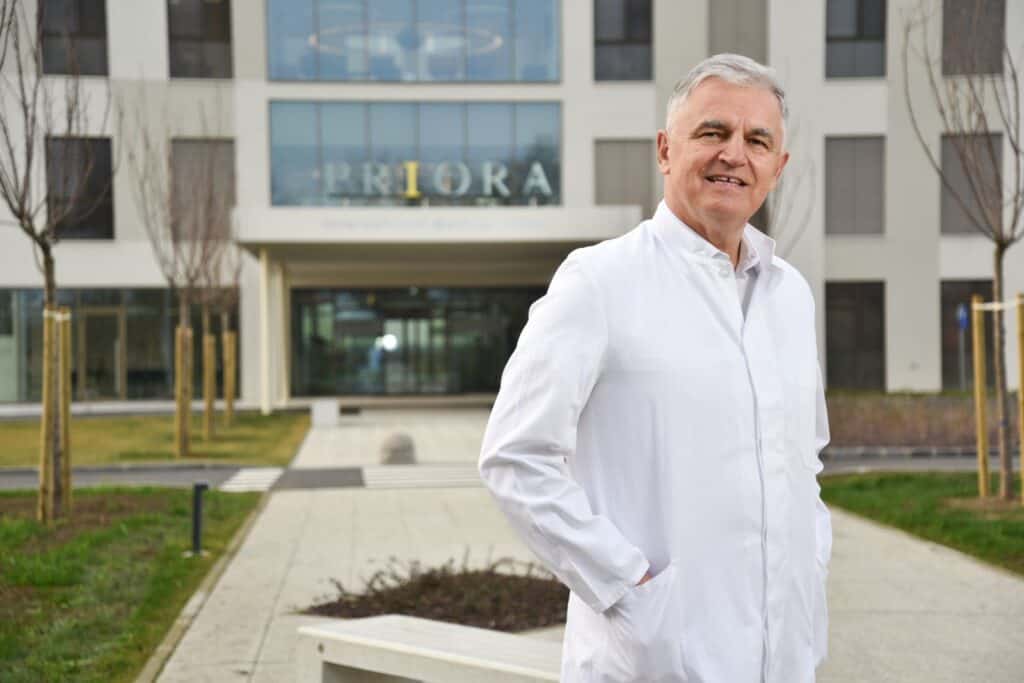Exactly 30 years ago, plastic surgeon Prof. Milomir Ninković, PhD, performed the first breast reconstruction using vascular flaps from the lower abdomen. The method, which was still in its infancy at the time, is now the standard worldwide
For a woman suffering from breast cancer, the loss of a breast is not just a physical wound – it deeply affects her self-image and everyday self-confidence. Reconstruction is therefore not just an aesthetic procedure, but an important step on the path to emotional and physical healing.
Exactly three decades ago, plastic surgeon Prof. Milomir Ninković, PhD, performed the first breast reconstruction using vascular flaps from the lower abdomen. The method, which was still in its infancy at the time, is now the standard worldwide. The beginnings, however, were not simple.

Breast reconstruction
Throughout the history of reconstructive and plastic surgery, there has been a tendency towards breast reconstruction, only the methods have changed. With the introduction of microsurgical methods in the 1980s, related to the so-called post-traumatic surgery, the technique of microsurgical tissue transfer began to be applied in breast reconstruction as well – begins Professor Milomir Ninković, Head of the Department of Plastic, Reconstructive, Aesthetic Surgery and Hand Surgery at the Priora International Medical Center in Čepin.
He also recalls the Swedish plastic surgeon Hans Holmström, who in the late 1970s published the results of a new technique for breast reconstruction using tissue from the lower abdomen.
– The idea for this venture was given to him by a patient who commented that it was a shame that, after aesthetic procedures for tummy tucks, all the excess tissue was thrown away. Wouldn’t it be useful, she asked him, to use it for breast reconstruction? It has the same consistency, as well as enough skin. Holmström thought about it and performed two operations using the tied flap method. He transferred tissue from the lower abdomen, through the muscle as a carrier of blood vessels, to the breast area, pulling it through a skin tunnel. He aroused enormous interest among fellow plastic surgeons, and this technique was particularly intensively used in Atlanta, USA – says Dr. Ninković, who knew Dr. Holmström personally and they talked about it a lot.
Breast reconstruction – Dr. Milomir Ninković
The famous plastic surgeon Michael Scheflan from Atlanta visited Ljubljana in the mid-80s, where he also met a young colleague from Sarajevo, Dr. Milomir Ninković.
– At the medical congress, he demonstrated the technique of breast reconstruction, so we asked him to perform such an operation together in Ljubljana. That operation was not so successful, a large part of the tissue failed. Then the Ljubljana plastic surgeon Zoran Arnež decided to apply microsurgical methods: he completely separated the tissue from the lower part of the abdomen, leaving it on one blood vessel, and then transplanted it to the breast area – recalls Milomir Ninković.
This is how the flap developed, which was initially transmitted in combination with skin and muscle. Today, on the other hand, only the skin and fatty tissue of the abdomen are transferred – without taking the muscles of the abdominal wall as carriers of the blood supply. The blood vessel is isolated from the muscle, which significantly reduces the trauma for the patient and preserves the functions of the abdominal wall.

This was the beginning of revolutionary procedures in breast reconstruction. After Dr. Ninković joined the Clinic for Plastic and Reconstructive Surgery at the Medical University of Innsbruck in the fall of 1992, he devoted himself, among other things, to breast reconstruction using microvascular flaps.
Not everything went smoothly there either. The problem arose – to which blood vessel should the flap taken from the abdomen be tied? The answer was provided by an anatomical study and clinical application of the results of the anatomical study, which was led by Professor Ninković and his colleagues from the Clinic for Plastic Surgery in Innsbruck, in collaboration with the Anatomical Institute. It was published in 1995 in the British Journal of Plastic Surgery. The study showed how this problem could be overcome by connecting the flaps from the abdomen to a blood vessel located directly behind the ribs, which cardiologists normally use for heart bypass surgery.
Professor Ninković has been working on the same principle for 30 years, which he developed together with his Austrian colleagues. He has performed hundreds of such procedures, with which he has restored not only the shape of his body, but also faith in himself and new hope for a better future for his patients. Each reconstructed breast tells a story of courage, struggle and victory.
– There are many places on the body from which tissue for breast reconstruction can be taken – from the lower abdomen, the inner thigh, the upper or lower parts of the buttocks… All that is important is the microsurgical ability to transfer that tissue from one place to another and connect it – he says. Such procedures take four to five hours, and are technically quite complex.

One of the current methods of breast reconstruction after cancer surgery is placing an implant in a preserved skin “pocket”.
– Each implant has a limited lifespan, and if the patient reacts to it as if it were a foreign body, capsular fibrosis can develop in 15 to 30 percent of patients, especially in the case of subsequent radiation. Reconstruction with the patient’s own fatty tissue, connected to the skin, provides a result that lasts a lifetime, and the breast has a normal consistency and color – concludes Prof. Milomir Ninković, PhD.